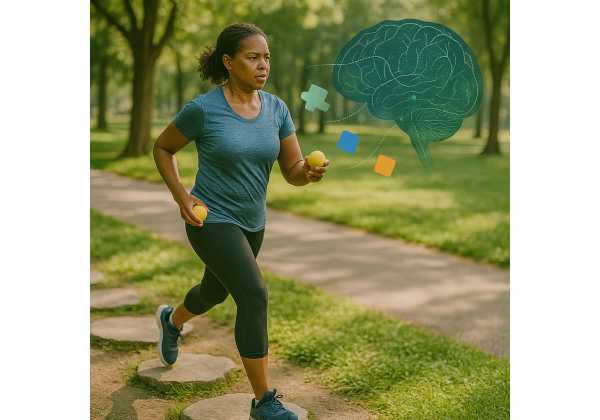
When you pair a thinking task with a simple movement—naming animals while walking, stepping sideways while solving mental math—you train the brain to coordinate attention, planning, and balance in real-world conditions. That is exactly where age-related slips often begin: we trip when distracted, lose the thread of a conversation on the stairs, or slow down during busy crossings. Dual-task training targets this overlap. It blends cognitive work with gait or posture challenges to improve safety, confidence, and day-to-day function. Below you will find a practical guide—why it works, how to start at home, how to progress safely, and how to measure gains. If you want a broader primer on memory and attention across adulthood, see our overview of evidence-based brain longevity.
Table of Contents
- Why Cognitive–Motor Training Supports Aging Brains
- At-Home Drills: Countbacks, Naming Games, and Steps
- Gait Plus Brain: Turns, Obstacles, and Reaction Challenges
- Progressions: Pace, Complexity, and Unpredictability
- Safety First: Footwear, Lighting, and Space
- How Often and How Long to Practice
- Tracking: Errors, Speed, and Confidence
Why Cognitive–Motor Training Supports Aging Brains
Walking in a quiet hallway is one thing; walking while checking the time, chatting, and scanning for a curb is another. That added cognitive load is where falls, near-misses, and mental fatigue often appear with age. Dual-task training deliberately practices this combined demand so the brain learns to allocate attention, suppress distractions, and coordinate body movements under pressure.
Here is what changes with consistent training:
- Executive control becomes more efficient. Executive skills—shifting, inhibiting, updating—drive safe multitasking. Under dual-task practice, the prefrontal networks that manage these skills learn to share resources better with motor regions. Over weeks, people typically show small-to-moderate improvements in global cognition and executive measures alongside faster or more stable walking.
- Gait stability improves under distraction. Many people can walk faster in a quiet setting but slow dramatically during conversation. Training narrows that gap. The “dual-task cost” (the percentage drop from normal walking to walking-plus-thinking) tends to shrink, which is a practical sign of resilience in busy environments.
- Speed and reaction control adapt. Paired cognitive tasks—verbal fluency, mental arithmetic, or 1-back memory—challenge response timing. The motor system, in turn, calibrates step length, cadence, and turning strategies to match the cognitive load. The result: smoother turns, fewer missteps, and steadier pacing when attention is split.
- Mood and confidence often lift. Programs that combine thinking and moving can reduce worry about falling and support motivation. That matters because fear-based slowing increases fall risk; confidence—built on real wins—promotes active, engaged walking.
Why this helps aging brains specifically:
- Reserve and redundancy. Training the brain to handle shared demands builds “reserve,” the ability to recruit alternative networks when one pathway is taxed. Reserve does not stop aging, but it can delay when everyday tasks start to feel hard.
- Vascular and metabolic benefits. The movement portion supports blood flow and glucose handling, which are critical for attention networks. The cognitive portion keeps those networks active and adaptable.
- Ecological validity. Practicing tasks that resemble sidewalks, stores, and social settings transfers better than seated drills alone. Dual-tasking is “practice for real life.”
Expect progress to feel subtle at first: a steadier stride during conversation, fewer word-finding stalls when turning, or less mental “white noise” on busy days. Those are early wins and strong reasons to continue.
At-Home Drills: Countbacks, Naming Games, and Steps
You can start dual-task training with simple, repeatable drills in a clear hallway or living room. Aim for sessions that mix one cognitive task with one movement at a time. Keep the movement safe and the brainwork just hard enough that speech slows slightly but posture stays tall.
Cognitive tasks (pick one per round):
- Countbacks: Start at 200 and subtract by 3s, 4s, or 7s. Switch the step size next round.
- Category naming: Name fruits, tools, or cities. To increase difficulty, alternate category items (fruit, tool, fruit, tool).
- Alphabet switching: Say A-1, B-2, C-3… or alternate letters (B, D, F…).
- N-back lite: Say a sequence (3-7-1-9). As you walk, repeat the number from one step ago (“1-back”) or two steps ago (“2-back”).
Movement options (pair with one cognitive task):
- Walk and talk: 10–20 meters out and back, natural pace.
- Step-and-hold: March in place, then every 5 counts hold one knee for 2 seconds while continuing the mental task.
- Side-steps: Slide right-left along a counter, hands light on the surface.
- Heel-to-toe line: Place tape on the floor; step along it while naming items.
- Sit-to-stand cycles: Stand from a chair, sit, and repeat while doing countbacks. Pause if form degrades.
How to structure a 20-minute home session:
- Warm up for 3 minutes (easy walking, shoulder rolls).
- Pick one cognitive task and one movement; practice for 2 minutes.
- Rest for 60–90 seconds—shake out legs, breathe.
- Repeat with a new pair (four to six total rounds).
- Cool down and note any stumbles or mental overload.
Make it social and sticky: Read a recipe aloud while pacing. Call a friend and do “name that category” during a gentle walk. Rotate tasks to keep motivation high. If you want to understand how learning protects networks over time, skim our explainer on building reserve through learning.
Safety checks: If speech collapses to single words, or you feel unsteady, lower difficulty: slow the pace, widen your stance, or switch to a simpler cognitive task. Quality beats quantity.
Gait Plus Brain: Turns, Obstacles, and Reaction Challenges
Most falls occur during complex walking—turning, avoiding obstacles, or starting and stopping. Build those elements into training once you can walk and talk comfortably on level ground.
1) Turns that test attention
- Set two cones (or mugs) 3–4 meters apart. Walk between them while alternating letters (A, C, E…). Each time you reach a cone, switch the task (now name vegetables). Turning plus task-switching simulates doorway navigation while conversing.
- Use gentle figure-eights around a single object while counting backward by 4s. Focus on smooth pivots rather than speed.
2) Low, safe obstacles
- Lay down two books or yoga blocks. Step over them while answering simple addition (4+9, 7+6). Keep blocks under mid-shin height. If toes clip, stop and lower the height.
3) Start-stop reactions
- Walk down a hall while a partner calls “red” (stop), “yellow” (slow), or “green” (go). If solo, use a metronome app: stop when you hear a double-beep. Layer a light mental task (e.g., name a color that isn’t on your clothing).
4) Head turns and scanning
- Look left and right every third step while listing animals. This trains vestibular-visual coordination plus working memory—useful for street crossings.
5) Carry and recall
- Carry a half-full water bottle on a tray while recalling a five-word list in order. Keep the tray low, elbows in, and take small steps. If water sloshes or posture crumples, you are over the line—dial down and rebuild.
Programming tips
- Insert one complex round (turns, obstacles, or reactions) between two simpler rounds.
- Keep total “complex minutes” to 6–10 within a 20–30 minute session early on.
- If you already track walking speed or reaction time, re-test monthly under dual-task conditions to see carryover.
To understand how walking metrics reflect brain processing—and why small gait changes deserve attention—see our short guide on gait signals and cognition.
Progressions: Pace, Complexity, and Unpredictability
Progress steadily, not aggressively. Raise one dial at a time—pace, task complexity, or unpredictability. Changing two dials at once often degrades form and learning.
Dial A: Pace
- Walk faster by 5–10% while keeping the same cognitive task. Use a hallway distance you can traverse in ~10–12 seconds; aim to shave 1 second without sacrificing posture or speech clarity.
- For stationary drills (marches, sit-to-stands), reduce the rest interval by 10–15 seconds.
Dial B: Cognitive complexity
- Move from single-category naming to alternating categories.
- Shift from countbacks by 3s to 4s or 7s.
- Upgrade from 1-back to 2-back (repeat the number from two items ago).
- When you notice smooth speech and fewer pauses, it is time to nudge difficulty.
Dial C: Unpredictability
- Add random turns (partner says “left,” “right,” or “back”).
- Use reaction cues (clap = stop, snap = start) while doing a low obstacle course.
- For solo sessions, create a shuffled cue deck: three index cards with “stop,” “turn,” and “speed up.” Flip one card every 10 steps.
Four-week example
- Week 1: Walk-and-talk at comfortable pace; category naming; simple head turns.
- Week 2: Add countbacks by 3s; figure-eight turns; brief start-stop cues.
- Week 3: Faster walking; alternating categories; low obstacles.
- Week 4: Mix in 2-back; random turns; longer reaction intervals.
Quality control rules
- If steps shorten drastically, knees lock, or you stop speaking, you over-progressed. Rewind one level.
- Feel for a “productive strain”—mental effort with clean posture. That is where adaptation happens.
- Sprinkle in an easy round after any demanding combination to consolidate learning.
For a deeper dive into why timing and repetition matter for adult learning, skim our overview on neuroplasticity windows, then return to your plan with one thoughtful tweak.
Safety First: Footwear, Lighting, and Space
Dual-task wins mean little if the setup is risky. Make safety part of the training habit.
Environment checklist
- Clear the lane: Remove loose rugs, cords, and clutter from a 3- to 5-meter path.
- Light it well: Use bright, even lighting. Avoid glare on shiny floors.
- Stable surfaces nearby: Practice next to a countertop or sturdy rail for light fingertip support during new drills.
- Partner or supervision: Early sessions are smoother with a spotter. If training solo, keep your phone on you.
Footwear and equipment
- Shoes: Closed-heel, non-slip soles. Avoid backless slippers and thick, squishy midsoles that wobble on turns.
- Assistive devices: If you use a cane or walker, train with it. Add cognitive tasks only when your device handling is automatic.
- Obstacles: Start with flat tape lines, then low, soft items (foam blocks), before rigid objects.
Personal risk factors (flag before progressing)
- Recent falls (past 3 months) or near-falls with injury.
- Dizziness, vertigo, or new imbalance.
- Vision changes (new blurring, double vision, or poor contrast at night).
- Foot pain, neuropathy, or new weakness.
- Medications that cause drowsiness or sudden blood pressure drops.
If any of these apply—or if you feel “pulled” to one side during head turns—scale down and consult a clinician. For targeted strategies if dizziness or spatial disorientation are issues, review the tips in vestibular health and balance.
Red-line rules during training
- No drills on stairs, thresholds, or uneven ground until basic combinations are stable.
- Stop immediately if chest pain, marked breathlessness, or sudden headache occurs. Report persistent symptoms to your clinician.
- Hydrate, and avoid training when overly fatigued or after alcohol.
Safety is not a barrier; it is a platform. When your environment is predictable and your footwear stable, dual-task training becomes focused, measurable, and rewarding.
How Often and How Long to Practice
You do not need marathon sessions. The brain responds to frequent, well-structured practice more than occasional heroic efforts.
Starting dose
- 20–30 minutes per session, most days, works well for beginners. Within that window, spend 6–10 minutes on the trickiest combinations (turns, obstacles, reactions), separated by easier rounds.
- If time is tight, use two 10-minute “snacks” separated by several hours. Short, frequent exposures consolidate learning without over-tiring.
Weekly rhythm
- 2–3 focused sessions per week (30–45 minutes each) plus lighter daily snacks build momentum.
- Plan one easier day after any high-challenge session to reduce overload and protect confidence.
Progress milestones
- Weeks 1–2: Learn the structure; find safe baselines; cut dual-task cost a few percentage points.
- Weeks 3–4: Add faster walking or a harder mental task; notice smoother turns.
- Weeks 5–8: Mix unpredictability (random cues) and carryover into errands. Many people report steadier phone conversations during walks.
Intensity cues
- You should be able to speak in short phrases. If you can only manage single words, ease off.
- Movement should stay crisp: tall posture, clear foot placement, controlled turns. If these slip, the dial is set too high.
Finally, remember the bigger picture: dual-tasking is one part of a brain-healthy lifestyle that also includes sleep, strength, and connection. If you are sorting out what “normal aging” looks like versus warning signs, our primer on typical changes versus risks can help you set expectations and adjust your plan.
Tracking: Errors, Speed, and Confidence
Measuring progress keeps training honest and motivating. A simple log turns “I think I am better” into evidence you can act on.
1) Dual-task cost (DTC) for walking
- Choose a 10-meter path. Time your normal walk (single task). Then repeat while naming animals (dual task).
- Compute DTC (%) = ((dual-task time − single-task time) / single-task time) × 100.
- Example: 8.0 s single, 9.2 s dual ⇒ DTC = (1.2 / 8.0) × 100 = 15%.
- Track monthly. A shrinking DTC suggests better attention sharing. (Expect fluctuations—sleep, stress, and illness can nudge numbers.)
2) Error counts and fluency
- For category naming, tally correct items per 30 seconds while standing still and while walking. Compare the two. Aim to maintain at least 80–90% of your seated/standing fluency during walking as training advances.
- For countbacks, note hesitations or restarts. Fewer stalls at the same walking pace = progress.
3) Turns and obstacles
- Count missteps or toe taps over a low obstacle course (e.g., 10 passes). The goal is not zero forever, but consistent decline across weeks.
4) Confidence scale
- After each session, rate, “How confident did I feel moving and thinking together?” on a 0–10 scale (0 = not at all, 10 = fully confident). Sustained gains of 2–3 points reflect real-world carryover even when speed changes are small.
5) Energy and carryover notes
- Keep a one-sentence note on what felt easier in daily life—talking while carrying groceries, navigating a busy kitchen, or stepping off a curb while answering a question. These anecdotes capture meaningful wins that numbers miss.
Troubleshooting plateaus
- If DTC stalls for four weeks, rotate the cognitive task (switch category naming to 1-back) or adjust pace by 5–10%.
- If fluency drops sharply under dual task, hold pace steady and simplify the mental task until speech smooths, then re-build.
When to re-baseline
- After illness, travel, or a long break, redo single-task and dual-task timings and rebuild from easier combinations. Momentum returns faster than you expect when you follow the same structure.
Evidence-informed training meets everyday practicality when you record a few numbers and one or two observations. Keep it simple, keep it steady, and let the notebook show you how far you have come.
References
- Dual-task training in older adults with cognitive impairment: A meta-analysis and trial sequential analysis of randomized controlled trials (2024) (Systematic Review)
- Effect of physio-cognitive dual-task training on cognition in pre-ageing and older adults with neurocognitive disorders: A meta-analysis and meta-regression of randomized controlled trial (2024) (Systematic Review)
- World guidelines for falls prevention and management for older adults: a global initiative (2022) (Guideline)
- Dual-Task Gait as a Predictive Tool for Cognitive Impairment in Older Adults: A Systematic Review (2021) (Systematic Review)
- Effects of dual-task resistance exercise on cognition, mood, depression, functional fitness, and activities of daily living in older adults with cognitive impairment: a single-blinded, randomized controlled trial (2024) (RCT)
Disclaimer
This article provides general information on dual-task training for adults and older adults. It is not a substitute for personalized medical advice, diagnosis, or treatment. Always consult your clinician or a qualified physical therapist before starting or changing an exercise program, especially if you have dizziness, vision changes, neuropathy, recent falls, cardiovascular symptoms, or other health concerns.
If you found this guide useful, please consider sharing it with a friend or on Facebook, X, or your preferred platform, and follow us for future updates. Your support helps us continue producing careful, practical resources on brain health.










